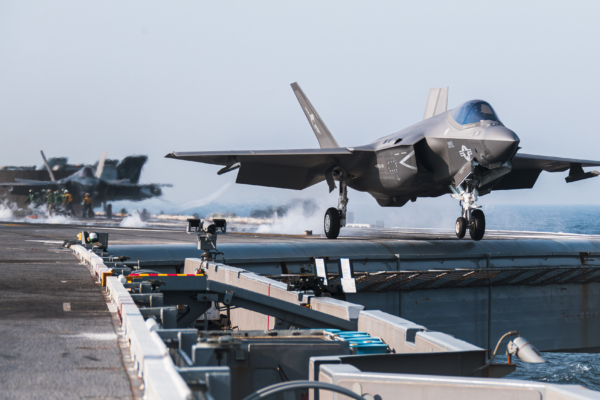Amid ongoing military actions by the Chinese Communist Party in the Taiwan Strait and East China Sea, the United States is also stepping up its military presence in Japan. As the US Navy’s USS George Washington aircraft carrier prepares to head to its forward-deployed base in Japan, on Monday (July 15), the Navy announced that it would be sending a squadron of F-35 fighter jets to the Iwakuni Air Base in Japan to join the Carrier Air Wing 5. Defense analysts indicate that the deployment of F-35Cs to Japan is aimed at countering the Chinese Communist Party.
According to a news release issued by the US Navy on Monday, the F-35C Lightning II fighters of Strike Fighter Squadron 147 will replace the F/A-18 Hornets of Strike Fighter Squadron 115, while the V-22 Ospreys of Fleet Logistics Multi-Mission Squadron 30 will replace the C-2A Greyhound transport aircraft of Fleet Logistics Support Squadron 30.
The news release stated that the F-35C is the most powerful fighter jet in the US Navy’s arsenal and serves as a cornerstone of air superiority, providing a dominant multi-role fifth-generation aircraft for carrier strike groups, enhancing the US military’s power projection and deterrence capabilities.
Currently, Carrier Air Wing 5 is embarked on the USS Ronald Reagan aircraft carrier, which is set to return to the US for maintenance later this year. The USS George Washington aircraft carrier will arrive at its forward-deployed base in Japan later this year, becoming a key part of the US military’s presence in Yokosuka. The Carrier Air Wing 5 will then transition to the USS George Washington aircraft carrier.
The USS George Washington previously served as the forward-deployed aircraft carrier for the US Navy in Yokosuka from 2008 to 2015.
“The security environment in the Indo-Pacific requires the US Navy to deploy its most powerful ships and aircraft forward. This posture enables naval forces to rapidly respond alongside joint forces, and gives our most powerful ships the greatest impact and operational capability,” the Navy stated.
The F-35C is a variant of the F-35 designed specifically for aircraft carriers, featuring the widest wingspan of all F-35 models and equipped with landing gear for arresting on carrier decks. The foldable wingtips of the F-35C help save space, allowing for more aircraft to be accommodated on carriers.
Defense analysts note that the deployment of the stealth F-35C fighter jets to Japan represents a significant enhancement of US military capabilities, demonstrating the Navy’s use of fifth-generation aircraft to counter Chinese stealth aircraft.
Japanese newspaper Nikkei reported that Masashi Murano, Chairman of the Hudson Institute in Washington, Japan, stated, “The exceptional networking and stealth capabilities of the F-35C are unmatched by fourth-generation fighters like the F/A-18 Hornet, no matter how much they are upgraded.”
Murano told Nikkei that the F-35C not only provides tactical advantages for naval aircraft in air-to-air combat against new Chinese fighters but also effectively counters anti-ship ballistic missiles launched by China and anti-ship cruise missiles fired by Chinese bombers.
“The prioritization of deploying fifth-generation carrier-based fighters to Japan indicates that the adversarial environment in the Western Pacific requires carrier-based aircraft with higher networking capability, penetration, and lethality,” he said.
The US Navy stated that the forward deployment of Strike Fighter Squadron 147 and Fleet Logistics Multi-Mission Squadron 30 not only supports US defense in Japan but also fulfills critical commitments to security and stability in the Indo-Pacific region. These military forces directly support the US defense strategic guidance by deploying the most powerful forces in the Indo-Pacific region.
Furthermore, the Navy news release added that compared to the traditional C-2A, the Navy’s V-22 variant offers a greater operational range, faster cargo handling and aerial refueling capabilities, improved survivability, and enhanced beyond-line-of-sight communications. This transport aircraft provides agility, flexibility, and sustainability to effectively support naval forces in high-end combat situations. The CMV-22B represents a core element of the next generation of Carrier Onboard Delivery (COD) mission capability and is a key enabler in ensuring the continued deployment flexibility of carrier strike groups.
Prior to the US Navy’s strengthening of its military deployment in Japan, on July 4, the US Air Force announced the permanent deployment of 36 F-15EX Eagle fighters to the Kadena Air Base in Okinawa and 48 F-35A Lightning II fighters to the Misawa Air Base in the north. These aircraft will replace the older F-15 fighters at Kadena Air Base and the F-16 fighters at Misawa Air Base.

